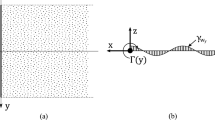Abstract
The paper refers to the solution of the integral equation for the acceleration (or pressure) potential for the study of subsonic linearized unsteady flow in view of aeroelastic applications. The case considered is relevant to a trapezoidal wing infinitely thin surface without discontinuities. As is well known [1, 2], the kernel of the integral equation exhibits three singularities, two of which are integrable in elementary form, whereas, for the third one integration in principal part according to Hadamard's rule is necessary. The kernel is therefore reworked in such a way that all the singularities are separated from the regular part, and eventually the discretization is performed in such a way that only the regular part is to be recalculated for each new value of the reduced frequency. Convergence tests, comparison with other methods of solution, and time saving associated with the technique of separation are also shown.
Sommario. II lavoro tratta la risoluzione del problema relativo alla equazione integrale nel potenziale di accelerazione (o di pressione) per lo studio di una corrente subsonica linearizzata nonstazionaria, in vista di applicazioni aeroelastiche. Il caso considerato è quello di una superficie alare a pianta trapezoidale in assenza di discontinuità di spessore infinitesimo. Come è noto [1, 2], il nucleo della equazione integrale in parola presenta tre singolarità, due sole delle quali sono integrabili in forma elementare, (o riconducibili ad essa), mentre per la terza è necessario far ricorso alla integrazione in parte principale alla Hadamard. Il nucleo stesso viene quindi rielaborato in modo da isolare tutte le singolarità dalla componente regolare del nucleo; si procede così alla discretizzazione dell' equazione integrale, e, per ogni valore della frequenza ridotta, va ricalcolata solo la parte regolare della matrice risolvente. Vengono poi effettuati tests di convergenza, confronti con altri metodi di soluzione, analisi sui tempi di calcolo e risparmio di tempo di calcolo dovuto alla tecnica di separazione.
Similar content being viewed by others
References
Ashley, H., Windall, S. and Landahl, M.T., 'New directions in lifting surface theory', AIAA J. 3(1) (1965) 3–16.
Landahal, M.T. and Stark, V., 'Numerical lifting-surface theory – problems and progress', AIAA J. 6(11) (1968).
Lan, C.E., 'A quasi-vortex-lattice method in thin wing theory', J. Aircraft, 11 (1974).
Woodcock, D.L., A Comparison of Methods Used in Lifting Surface Theory, Agard-R-583–71.
Morino, L., Computational Methods in Potential Aerodynamics, Springer-Verlag, 1985.
Santini, P., 'A general computer program for the calculation of the generalized aerodynamic forces', Presented at 47th Meeting of SMP AGARD, Florence, Italy, September 1978.
Weissinger, J., 'Uber eine Erweiterung der prandtlschen Theorie der tragenden Linie' Math. Nachr. 2 (1949) 45–106.
Truckenbrodt, E., Tragflachentheorie bei inko pressibler Stromung, Jb.WGL, 40–65, 1953.
Hess, J.L., Calculation of Potential Flow about Arbitrary Three-Dimensional Lifting Bodies, DAC Report No. MDC J5679–01, 1972.
Watkins, C.E. and Runyan, H.L., On the Kernel Function of the Integral Equation Relating the Lift and Downwash Distribution of OscillatingFiniteWing In Subsonic Flow, NACA TR 1234 Langley Aeronautical Laboratory, 1959.
Wagner, S., 'On the singularity method of subsonic lifting-surface theory, J. Aircraft 6(6) (1969).
Multhopp, H., Die Berechnung der Auftriebsverteilung von Tragflugeln Lufo., 15, 1938, pp. 153–180, Jb. Lufo., I, 1938, pp. 101–128.
Haftka, R.T. and Yates, E.C., 'Repetitive-flutter calculations in structural design', J. Aircraft 13(7) (1976) 454–461.
Edwards, J.W., Breakwell, J. and Bryson, A., 'Active flutter control using generalized unsteady aerodynamic theory', J. Guidance and Control 1(1) (1978).
Geisler, W., Prediction of the Unsteady Airloads on Oscillating Lifting Systems and Bodies at Subsonic and Supersonic Flow, von Karman Institute for Fluid Dynamics lecture series 1979-8, Aeroelastic Problems in Aircraft Design, May 7–11, 1979.
Lottati, I. and Nissin, E., 'Three-dimensional oscillatory piecewise continuous-kernel function method', AIAA J. Aircraft 18(5) 1981.
Santini, P., Gasbarri, P. and Coppola, C., Gli effetti Di spessore nella Valutazione della Distribuzione delle Pressioni sulla Superficie del Timone, I.N.S.E.A.N., TR cod.243/R.
Battisti, C., Effetti Non Lineari nella Idrodinamica dei Timoni (Nonlinear Effects in Rudders Hydrodynamics), Dissertation, Università la “Sapienza”, Roma, Dipartimento Aerospaziale, 1996.
Gasbarri, P., Aerodinamica non Stazionaria: un Regime Subsonico, PhD Thesis in Aerospace Engineering, Università la “Sapienza”, Roma Dipartimento Aerospaziale, February 1993.
Author information
Authors and Affiliations
Rights and permissions
About this article
Cite this article
Santini, P., Gasbarri, P. Lifting Surface in Subsonic Unsteady Regime. Meccanica 34, 1–27 (1999). https://doi.org/10.1023/A:1004311314673
Issue Date:
DOI: https://doi.org/10.1023/A:1004311314673




